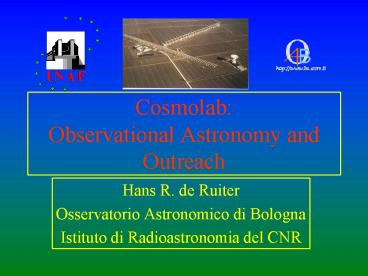Cosmolab: Observational Astronomy and Outreach PowerPoint PPT Presentation
1 / 16
Title: Cosmolab: Observational Astronomy and Outreach
1
Cosmolab Observational Astronomy and Outreach
- Hans R. de Ruiter
- Osservatorio Astronomico di Bologna
- Istituto di Radioastronomia del CNR
2
Cosmolab Science and Outreach
- AstroMD is intended to be a tool for Scientific
- Research and Divulgation
- 3D representation of data sets with three spatial
- coordinates.
- 3D representation of data sets using other
coordinates - (e.g. radial velocity)
- 3D representation of observational data quality
checks
3
Example of data set Hipparcos
Hipparcos satellite 150000 stars, precise
distances 1000000 stars, less precise
distances (Tycho dataset) 3D environment of sun
out to 1000-10000 light years
4
Hipparcos and the Milky Way
- Size of Hipparcos Sphere
- 3000 light year
- Size of Milky Way
- 100000 light year
- 150,000 to 1,000,000 stars
- Milky way 100,000,000,000 stars
- (1few 100,000)
- Hipparcos sphere
5
Galaxies the 3D structure of radio jets (1)
Image courtesy of NRAO/AUI
6
Galaxies the 3D structure of radio jets (2)
- Purpose reproduction of 3D structure of radio
jets - Use total intensity, polarization, magnetic
field information - Use modelling of physics synchrotron emission
gives gas density, bulk velocity (may be
relativistic). - Visualize orientation effects Doppler beaming
7
Galaxies Visualization of gas flows
- (Radio) observations in spectral lines
- Molecules like CO, Water Masers, and many more
- Historically most important and still extensively
used is the Hydrogen line at 21 cm wavelength.
This line can be used in observations of external
galaxies to map velocity field (frequency shift
due to Doppler effect). - Need receiver with many frequency channels, e.g
WSRT and VLA
8
Example of an HI observation One of the
galaxies oserved with WSRT in HI project WHISP
9
Galaxies the structure of the Universe (1)
A spiral galaxy like our own Milky way M
83. Image obtained with new ESO VLT Telescope
in Chile. Since beginning 2002 VIRMOS will
make deep galaxy surveys
10
Galaxies the structure of the Universe (2)
Many galaxies are active, i.e. they have nuclei
in which violent processes are taking place.
Example Radio Galaxy Cen A With VIRMOS
distribution and cosmic evolution of AGN
11
Galaxies the structure of the Universe (3)
Galaxies form clusters, superclusters and even
bigger structures (large scale filaments
millions of light years long. What are the
implication for the history of the
Universe? Future surveys like VIRMOS will tell
us.
12
Galaxies the structure of the Universe (4)
New surveys (like VIRMOS) will reach close to
observable edge of Universe, at epoch of galaxy
formation. 3D pictures of (pieces) of Universe
at different past epochs will be very useful tool
13
AstroMD
- A visualization tool for pattern recognition in
cosmological surveys 3D structure of extra
galactic space - Quality control and editing of (radio)
astronomical data dimensions of
interferometric data are antenna pairs
base-lines, time, intensity of signal - 3D planetarium a first application of AstroMD
will be in the Visitor Centre of the Institute of
Radio Astronomy in Medicina (Bologna), opening
foreseen next year
14
Quality Check and Editing of Obervational Data
- Example
- Westerbork Synthesis Radio Telescope
- Axes
- Time (12 hrs)
- Frequency
- Baselines (distance between antenna pairs)
15
Summary
- Cosmolab will be useful tool in data analysis and
data editing. Checking data cubes (or even higher
dimensions using color coding and time sequences)
may become much easier. - The 3D structure of the observed Universe may be
analyzed at a glance patterns may be recognized
immediately and studied in further detail. - Many astronomical data are at least three
dimensional in nature (but not necessarily three
spatial dimensions). The example of HI
observations shows how effective a truly 3D
representation may be. - A 3D planetarium using virtual guided tours
may be constructed with Cosmolab (cf. Visitor
Center at IRAlt Bologna).
16
Astronomy Lessons
The aim is to create a variety of paths through
AstroMD that guide people in an automatic way
through the software, however, allowing for a
certain flexibility (using predefined
buttons). The lessons may use the 3D capabilities
of AstroMD, and at the same time point to (for
example) html and WEB pages, with info on the
science contained in the lesson.
End presentation and open AstroMD

